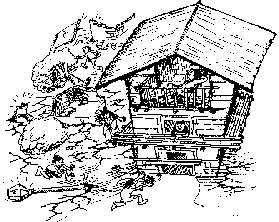Traditional house building techniques have successfully demonstrated, during past earthquakes in the Himalayan region, that there is inherent after component associated with the constructional design. This was found during the 1905 Kangra earthquake, the traditional Kat-Ki Kunni houses in Kullu valley made up of timber remained unaffected. The Dhajji-Diwari buildings remained intact in the 1885 Srinanage earthquake. Similarly, in Uttarkashi the traditional 100 years old multistoried buildings called Pherds have incorporated basic features of earthquake resistance.
The Pherols of Uttarkashi
Pherols are old traditionally built multistoried structures found in Uttarkashi district. The main materials of constructions are stone and wood with mud mortar. The construction is essentially coursed-rubble masonry type. The various earthquake resistant features in these types of houses are the use of wooden tie-bands as beams and vertical timber columns as pins to tie the inside and outside wyeths of a wall. Long stones with flat surfaces are distributed in the walls to make the loads vertical in the wall units and minimize the tendency of the wall stones to push or run outward. Moreover, to distribute some of the seismic load vertically corner reinforcements are provided by the use of wooden blocks and long flat stones. Also, the height of the floor is kept low and there are minimum numbers of openings, for keeping the centre of gravity low and also for insulation purposes (For more details on "The Pherols" see HB 8(3):5, 1997)

Dhajji-Diwari Buildings of Kashmir
The Dhajji-Diwari buildings were the one of survive when part of the palace and other massive old buildings collapsed in the Srinagar quake of 1885. The most significant aspect of the Dhajji-Diwari buildings is the combination of the building materials used. These materials are locally available and have been used for generations. The basic elements in these buildings are the load bearing masonry piers and infill walls. There are wooden tie-bands at each floor level. The foundation consists of rubble masonry with lime mortar whereas, mud mortar is used for the rest of the structure. The infill materials are usually abode bricks bonded with mud mortar. The wooden bands tie the walls of the structure with the floors and also impart ductility to a structure that is otherwise brittle. The unreinformced masonry walls have stiffness but not strength. In the absence of strength, flexibility is essential for quake resistance. Here, the desired flexibility is provided by the combination of wood and unreinforced masonry laid in a wear mortar. The wooden beams tie the whole house together and ensure that the entire building sway together as one unit in an earthquake.
Kat-Ki- Kunni Buildings of Kulu Valley
Similar to the Pherols and the Dhajji-Diwari buildings, the Kat-Ki-Kunni or timber cornered buildings suffered minimal damage in the epicentral tract of Kulu Valley during the 1905 Kangra earthquake. This structure is almost identical to the Pherols of Uttarkashi. It combines the weight, solidity an coolness of a stone building with the flexibility and earthquake-resisting qualities of a wooden one. Here the wood bonding takes place at vertical intervals of three to five feet. Two parallel beams are laid along with layer of masonry, one on the inside and one on the outside. At the end of one wall they are crossed by the beams on the walls at right angle, and the wooden pins hold the crossing together. Crossties of wood, similarly hold the two parallel beams in position at intervals along their length.q